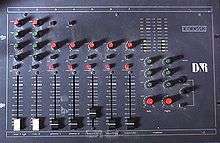Reverse echo
Reverse echo or reverse reverb, also known as backwards echo and reverse regeneration, is a sound effect created as the result of recording an echo or delayed signal of an audio recording played backwards. The original recording is then played forwards accompanied by the recording of the echo or delayed signal which now precedes the original signal.
Development
Guitarist and producer Jimmy Page claims to have invented the effect, stating that he originally developed the method when recording the single "Ten Little Indians" with The Yardbirds in 1967.[1] He later used it on a number of Led Zeppelin tracks, including "You Shook Me", "Whole Lotta Love", and their cover of "When the Levee Breaks". In an interview he gave to Guitar World magazine in 1993, Page explained:
| “ | During one session [with The Yardbirds], we were recording "Ten Little Indians", which was an extremely silly song that featured a truly awful brass arrangement. In fact, the whole track sounded terrible. In a desperate attempt to salvage it, I hit upon an idea. I said, "Look, turn the tape over and employ the echo for the brass on a spare track. Then turn it back over and we'll get the echo preceding the signal." The result was very interesting—it made the track sound like it was going backwards.
Later, when we recorded "You Shook Me", I told the engineer, Glyn Johns, that I wanted to use backwards echo on the end. He said, "Jimmy, it can't be done". I said "Yes, it can. I've already done it." Then he began arguing, so I said, "Look, I'm the producer. I'm going to tell you what to do, and just do it." So he grudgingly did everything I told him to, and when we were finished he started refusing to push the fader up so I could hear the result. Finally, I had to scream, "Push the bloody fader up!" And lo and behold, the effect worked perfectly.[2] |
” |
Despite Page's claims, an earlier example of the effect can distinctly be heard towards the end of the 1966 Lee Mallory single "That's the Way It's Gonna Be", produced by Curt Boettcher.[3][4][5][6]
Usage
Reverse reverb is commonly used in shoegaze, particularly by such bands as My Bloody Valentine and Spacemen 3.
Use in other media
Reverse echo has been used in filmmaking and television production for an otherworldly effect on voices, especially in horror movies.
Reverse echo is also often used as a lead-in to vocal passages in hardstyle music. It is used for the same reason in trance music, particularly by Cosmic Gate.
References
- ↑ Brad Tolinski and Greg Di Bendetto, "Light and Shade", Guitar World, January 1998.
- ↑ Interview with Jimmy Page, Guitar World magazine, 1993
- ↑ That's The Way It's Gonna Be review by Richie Unterberger at AllMusic
- ↑ Fennelly, Mike (2001). "Magic Time Box Set liner notes". albumlinernotes.com. Retrieved 13 August 2013.
- ↑ "That's the Way It's Gonna Be" on YouTube
- ↑ Priore, Domenic (1 July 2007). Riot on Sunset Strip: Rock'n'roll's Last Stand in 60s Hollywood. Outline Press, Limited. p. 184. ISBN 978-1-906002-94-7. Retrieved 12 August 2013.
